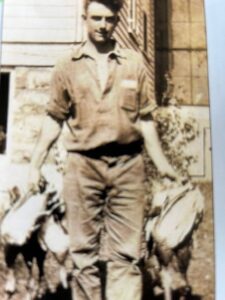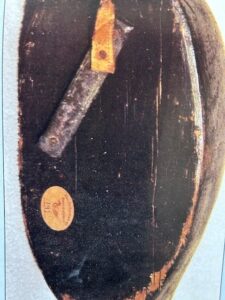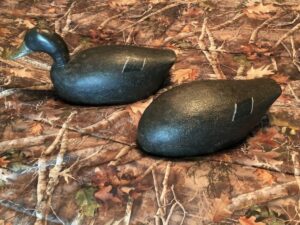An Oconto County, Wisconsin, Decoy Carver
A Decoy Corner Article
By Bruce Urben, WWA President

A 1930 photo of carver George Windross, Jr. Photo courtesy of Wisconsin Hunting and Fishing Collectibles magazine
I have not written much about decoy carvers from Northern Wisconsin, although the Bay of Green Bay, extending from Oconto County to Marinette County and into Michigan, was a waterfowling hotbed beginning in the early 20th century. Waterfowling hotbeds hatched many quality carvers out of need.
Early Northeast Wisconsin sportsmen were primarily engaged in farming, lumbering or hunting, fishing and trapping to provide for their families. One carver from southern Oconto County was a farmer and an avid bay waterfowler.
George Windross, Jr was born in 1904 and lived his entire life in and around the Kelly Lake and Oak Orchard areas near the city of Oconto. Oconto County was named after the Indian term meaning “many fish from many waters”. George inherited the family farm deeded to his father in 1846 by a U.S. Land Treaty. Family records confirm that George, Jr was an avid waterfowler, hunting with family and friends in area marshes and the Bay of Green Bay.
George, Jr began carving out of necessity, both to supplement his farming income and to provide quality decoys for neighbors and his own waterfowling passion. George, Jr carved oversized decoys because the large waters of Green Bay made smaller decoys difficult to be seen by ducks at a distance. He used primarily hand tools in his carving that were available to him on the farm. It is known that George carved mallards, canvasbacks, bluebills and black ducks over his lifetime. He is best known for carving beautiful black ducks, including headless feeders!

The bottom of on of George, Jr’s black ducks. Photo courtesy of Wisconsin Hunting and Fishing Collectibles magazine
His heads included fine bill carving and his paint scheme was simple in design and usually included colorful spectrums. His paint type was an oil based house paint. George used flat lead weights on the bottom and a leather strap for the rigging tie. He frequently signed the bottom of his decoys with “G Windross Pensaukee Lake, Wis.”
According to his son, only several black ducks still exist in the family collection.
George, Jr’s decoys are in high demand by collectors but are very rarely found in decoy auctions due to age and limited production.
George Windross, Jr passed away at the age of 77 in 1981. He is known as one of the finest carvers of Black Duck decoys and, of course, is another Wisconsin Original decoy carver!

